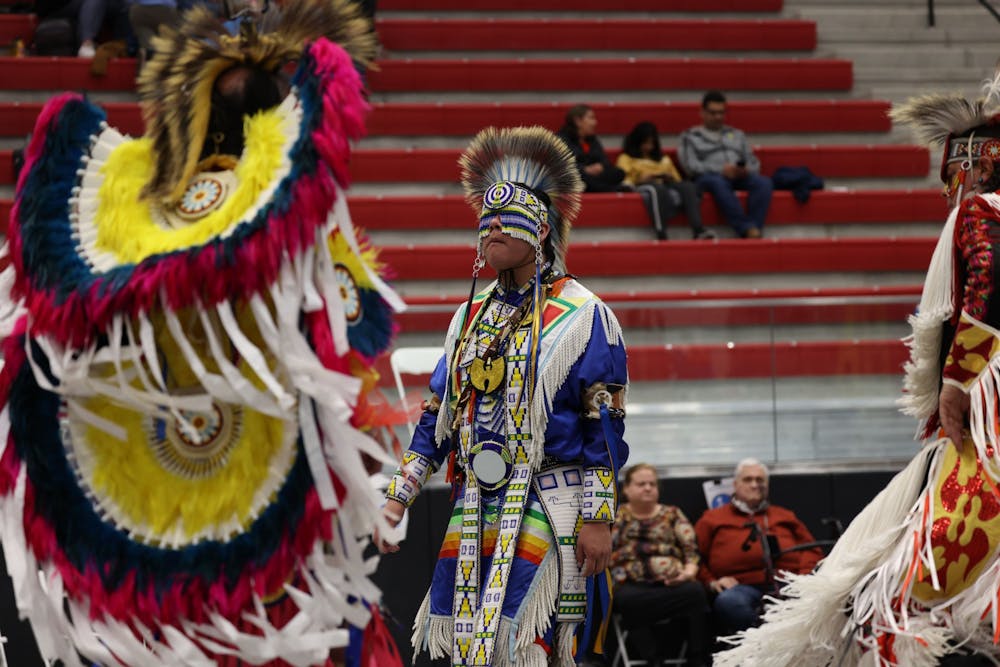The First Nations Educational and Cultural Center held the 11th annual IU Powwow on April 1 in Wilkinson Hall.
First Nations Educational and Cultural Center is a central part of the diversity initiatives at IU and aims to build a safe, supportive and inclusive Native community within IU. The annual Powwow is hosted, organized and set up by FNECC and Native American Student Association volunteers and committee members.
There have been two variations of the powwows at IU over the years, according to previous FNECC director, Dr. Nicky Belle.
According to First Nations IU, in 2002, Dr. Wesley Thomas — then director of First Nations at IU — hosted the first rendition of the IU Powwow, which took place in the Bill Garrett Field House at IU for several years. This version was a competition Powwow, which often attracts more dancers and singers, and prizes are given out at the end. In 2011, the first director of FNECC, Dr. Brian Gilley, brought the first annual Traditional Powwow to IU, which has no competition but is focused on bringing in community.
Each year since 2011, the Traditional Powwow has continued to outgrow its space, Belle said. The first year it was held in the Neal-Marshall Black Culture Center Grand Hall but moved to Cedar Hall the next year.
This year, Belle said the IU Powwow brought in nationally recognized singers and dancers such as Lonny and Verna Street.
Related: [IU Traditional Powwow returns Saturday]
Verna Street is a descendant of the Cherokee, Tuscarora and Meherrin Nations of North Carolina. She married Lonny Street of the Meskwaki tribe, who was Champion Men’s Traditional Dancer. They have continued their journey of powwows together for 20 years now.
Belle said along with the traditional dance circle at a powwow, there is also food provided and vendors who sell a wide variety of handmade items from arts and crafts to Native items.
One of the vendors at this year's Powwow was Shannon Turner of Navajo Nation. Turner sells southwest inspired pieces with her husband and four children. She said she makes pieces that are important to her culture such as jewelry with sacred stones.
She also sells bead work and other jewelry she makes within a two-week time frame. Turner said that she spends all day, every day for two weeks during her spring break making stuff for the event.
“I spend every moment during those two weeks making stuff,” Turner said. “It takes a lot of days and nights.”
However, in recent years, Turner said she is not alone in the jewelry making process. Her children have begun to pick up certain aspects, as well. Her daughter, Michelle Watson, has begun to help with the sales and vending process. Benjamin, Turner’s oldest son, has begun doing some bead work, such as with earrings. Her youngest has gotten into drawing and painting.
Related: [Food Truck Mondays to start April 3]
The vendors sell anything from a range of candles to jewelry and even maple syrup.
After the vendors opened at 10 a.m., the day continued with a Potawatomi Hand Games demonstration, Grand Entry and dance sessions throughout the afternoon and evening.
IU sophomore Kain Eller of the Lummi, Upper Skagit and Nooksack tribes, said this annual event is important for the Native community to have in Bloomington because there are no communities for Native students at IU.
Eller found the need for community and recognition on campus. He said there is little representation in Indiana as the lands are ethnically cleansed in this nation.
“It provides representation for our community,” said Eller. “It’s a place where we don’t have to be a minority in the room.”
Laurel Bills, of the Oglala Lakota tribe, said she has been attending powwows since she was born. She said she watched as the IU Powwow grew over the years and witnessed first-hand the change of venues and how spread out the event was able to be this year.
Bills said that, for her, the powwow is a way to connect with her Indigenous ancestry that is deeply rooted on her mom’s side and that powwows have always been a way to connect with people in the community.
Related: [NOTUS ensemble to feature premiere works by Jacobs faculty, students March 31]
“It’s a way to show that we are still here,” Bills said.
When asked her favorite part of the powwows, Autumn Brunelleschi, of the Turtle Mountain Anishinaabe tribe, said it’s the people.
Brunelleschi said she grew up going to powwows and described them as a ceremony of getting community together. Since she is far away from her community back home, she likes that IU does a powwow because she gets to feel at home.
From seeing friends and familiar faces from previous powwows to watching the first Grand Entry while everyone is gathered around and listening intently to the music and drums, the IU Powwow has created a community for many Bloomington residents.
“I love listening to the music and hearing people's laughter as they socialize and enjoy the powwow,” Turner said. “It makes us feel like we’re home.”






